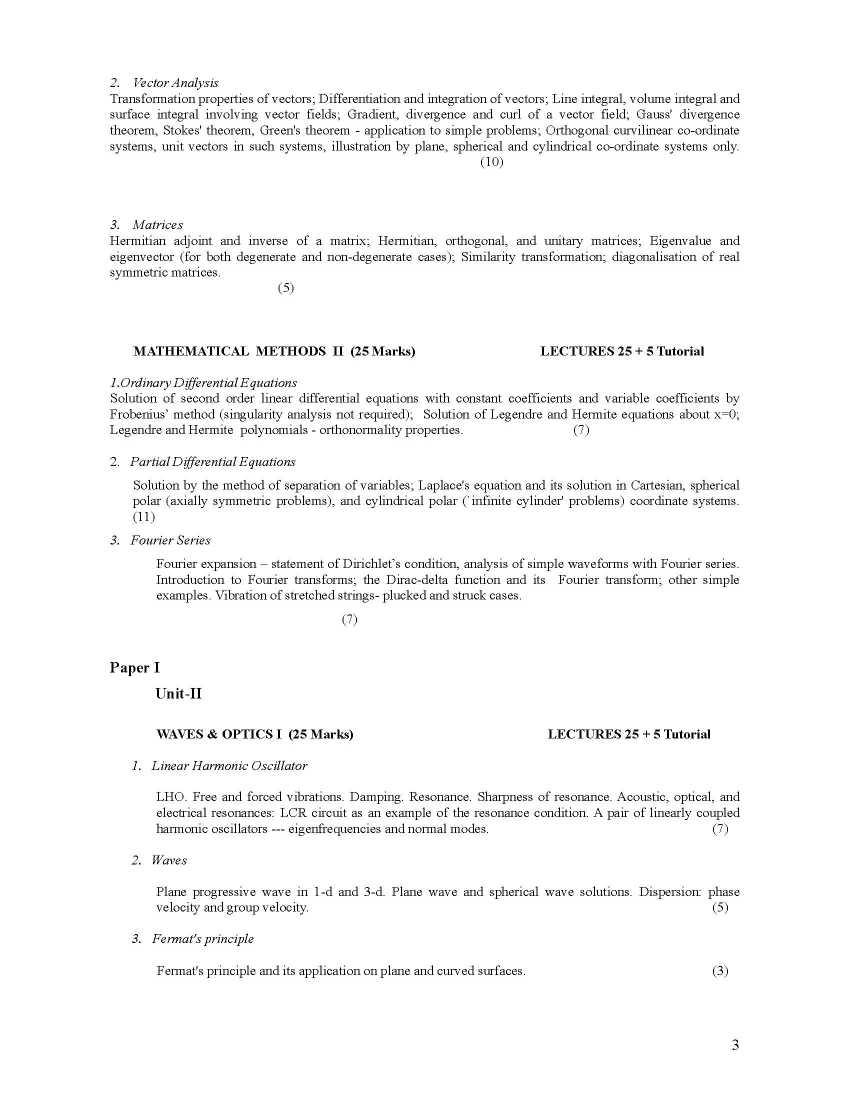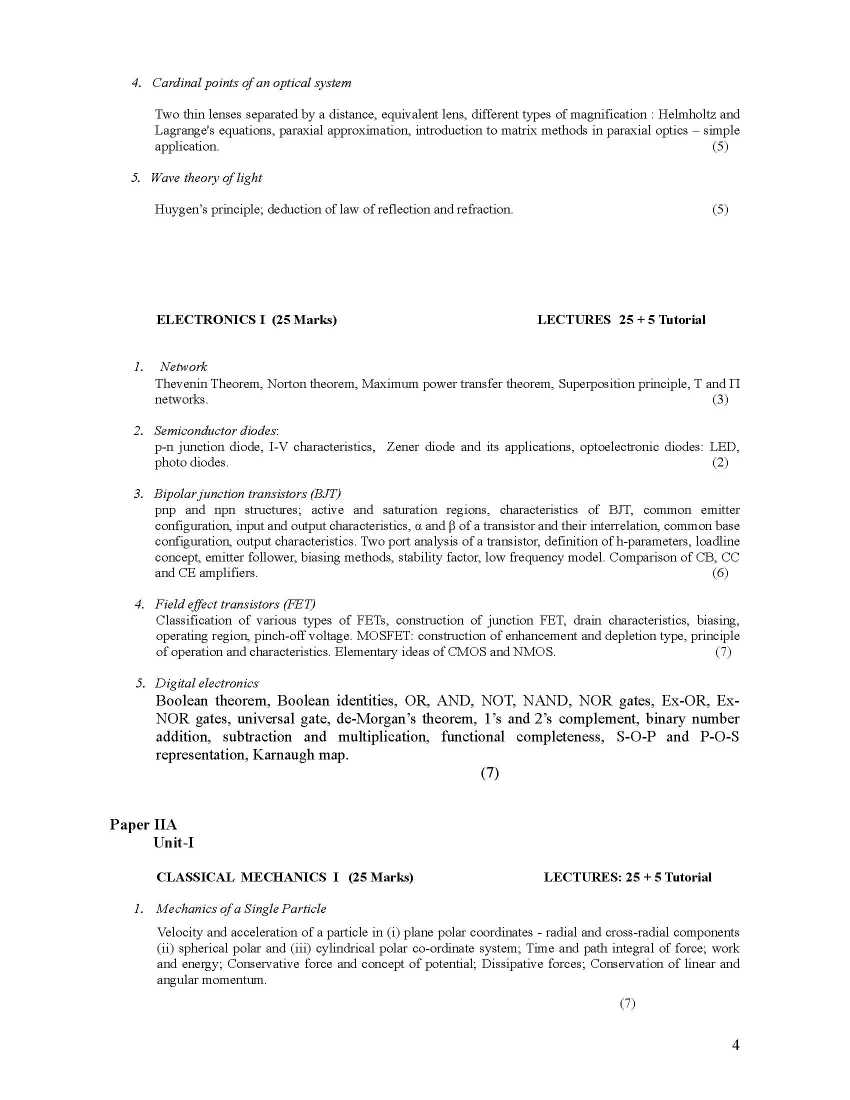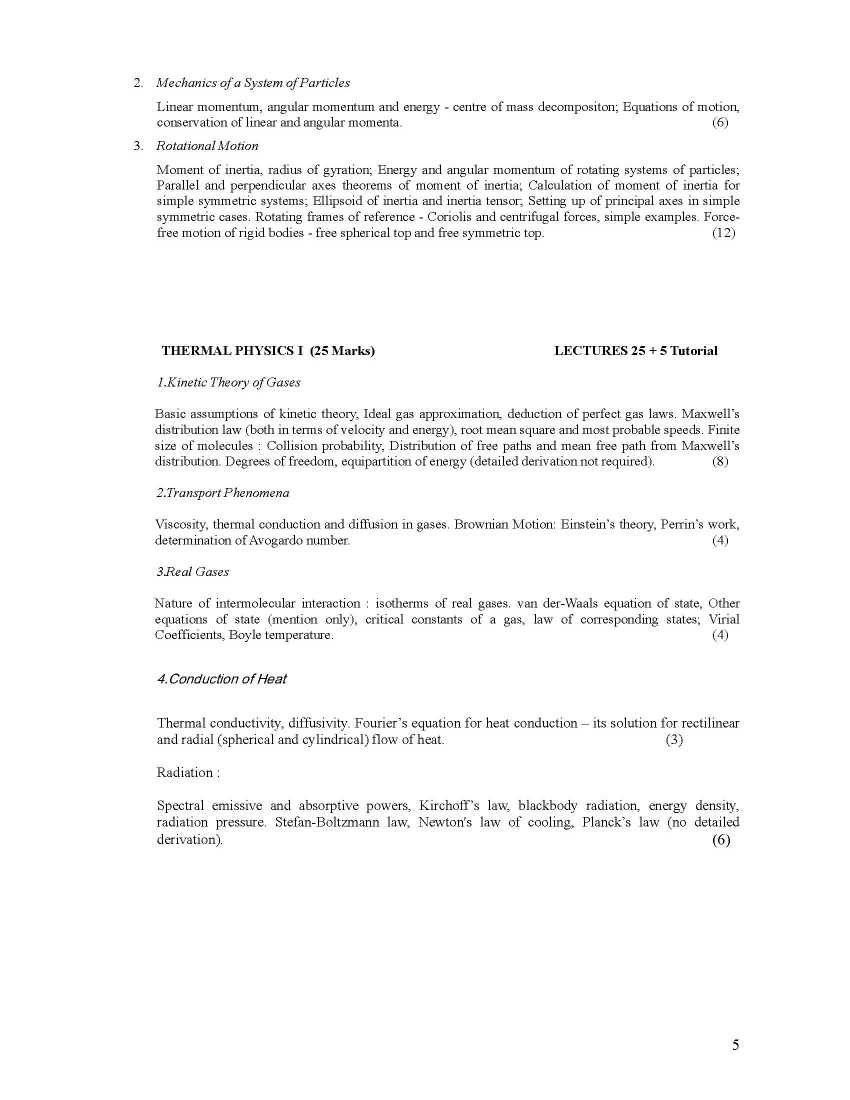|
#2
September 27th, 2017, 01:46 PM
| |||
| |||
| Re: University of Calcutta Physics Honours Syllabus
As you want syllabus of B.Sc Physics Honours Course offering by University of Calcutta, so here I am providing complete syllabus: University of Calcutta B.Sc Physics Honours Course Syllabus YEAR I Paper I (100 Marks) Unit-01: 50 Marks- Mathematical Methods I & Mathematical Methods II Unit-02: 50 Marks- Waves and Optics I & Electronics I Paper IIA (50 Marks) Unit-03: 50 Marks- Classical Mech.I & Thermal Physics I Paper IIB (50 Marks) Unit-04: 50 Marks- Laboratory YEAR II Paper III (100 Marks) Unit-05: 50 Marks- Electronics II & Electricity and Magnetism Unit-06: 50 Marks- Electrostatics & Waves and Optics II Paper IVA (50 Marks) Unit-07: 50 Marks- Quantum Mech.I & Thermal Physics II Paper IVB (50 Marks) Unit-08: 50 Marks- Laboratory YEAR III Paper V (100 Marks) Unit-09: 50 Marks- Classical Mechanics II & Special Theory of Relativity Unit-10: 50 Marks- Quantum Mech.II & Atomic Physics Paper VI (100 Marks) Unit- 11: 50 Marks- Nuclear and Particle Physics I & Nuclear and Particle Physics II Unit- 12: 50 Marks- Solid State Physics I & Solid State Physics II Paper VIIA (50 Marks) Unit- 13: 50 Marks- Statistical Mechanics & Electromagnetic Theory Paper VIIB (50 Marks) Unit- 14: 50 Marks- Laboratory Paper VIIIA (50 Marks) Unit- 15: 50 Marks- Laboratory Paper VIIIB (50 Marks) Unit- 16: 50 Marks- Computer laboratory YEAR I MATHEMATICAL METHODS I (25 Marks) 1. Preliminary Topics Infinite sequences and series - convergence and divergence, conditional and absolute convergence, ratio test forconvergence. Functions of several real variables - partial differentiation, Taylor's series, multiple integrals.Random variables and probabilities - statistical expectation value, variance; Analysis of random errors: Probabilitydistribution functions (Binomial, Gaussian, and Poisson) 2. Vector Analysis Transformation properties of vectors; Differentiation and integration of vectors; Line integral, volume integral andsurface integral involving vector fields; Gradient, divergence and curl of a vector field; Gauss' divergencetheorem, Stokes' theorem, Green's theorem - application to simple problems; Orthogonal curvilinear co-ordinatesystems, unit vectors in such systems, illustration by plane, spherical and cylindrical co-ordinate systems only. 3. Matrices Hermitian adjoint and inverse of a matrix; Hermitian, orthogonal, and unitary matrices; Eigenvalue andeigenvector (for both degenerate and non-degenerate cases); Similarity transformation; diagonalisation of realsymmetric matrices. MATHEMATICAL METHODS II (25 Marks) 1.Ordinary Differential Equations Solution of second order linear differential equations with constant coefficients and variable coefficients byFrobenius’ method (singularity analysis not required); Solution of Legendre and Hermite equations about x=0;Legendre and Hermite polynomials - orthonormality properties. 2. Partial Differential Equations Solution by the method of separation of variables; Laplace's equation and its solution in Cartesian, sphericalpolar (axially symmetric problems), and cylindrical polar (`infinite cylinder' problems) coordinate systems. 3. Fourier Series Fourier expansion – statement of Dirichlet’s condition, analysis of simple waveforms with Fourier series.Introduction to Fourier transforms; the Dirac-delta function and its Fourier transform; other simpleexamples. Vibration of stretched strings- plucked and struck cases. WAVES & OPTICS I (25 Marks) 1. Linear Harmonic Oscillator LHO. Free and forced vibrations. Damping. Resonance. Sharpness of resonance. Acoustic, optical, andelectrical resonances: LCR circuit as an example of the resonance condition. A pair of linearly coupledharmonic oscillators --- eigenfrequencies and normal modes. 2. Waves Plane progressive wave in 1-d and 3-d. Plane wave and spherical wave solutions. Dispersion: phasevelocity and group velocity. 3. Fermat's principle Fermat's principle and its application on plane and curved surfaces. 4. Cardinal points of an optical system Two thin lenses separated by a distance, equivalent lens, different types of magnification : Helmholtz andLagrange's equations, paraxial approximation, introduction to matrix methods in paraxial optics – simpleapplication. 5. Wave theory of light Huygen’s principle; deduction of law of reflection and refraction. University of Calcutta B.Sc Physics Honours Course Syllabus     |